
Ammonoids are a group of extinct marine mollusc animals in the subclass Ammonoidea of the class Cephalopoda. These molluscs, commonly referred to as ammonites, are more closely related to living coleoids than they are to shelled nautiloids such as the living Nautilus species. The earliest ammonites appeared during the Devonian, with the last species vanishing during or soon after the Cretaceous–Paleogene extinction event.

Ammonitida is an order of ammonoid cephalopods that lived from the Jurassic through Paleocene time periods, commonly with intricate ammonitic sutures.

Acanthohoplites is an extinct genus of ammonites in the family Parahoplitidae that lived in the Aptian and Early Albian stages of the Early Cretaceous.

Aspidoceras is an extinct ammonoid cephalopod genus belonging to the family Aspidoceratidae.
Unipeltoceras is an extinct ammonite genus included in the perisphictacian family, Aspidoceratidae, and a member of the subfamily Peltoceratinae, that lived during the Callovian stage, late in the Middle Jurassic.

Ceratitida is an order that contains almost all ammonoid cephalopod genera from the Triassic as well as ancestral forms from the Upper Permian, the exception being the phylloceratids which gave rise to the great diversity of post-Triassic ammonites.
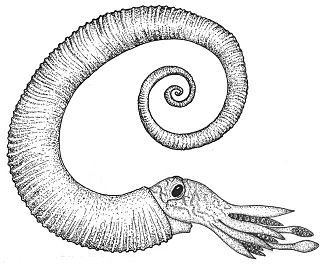
Turrilitoidea is a diverse superfamily of Cretaceous ammonites generally considered as heteromorphic and commonly included in the suborder Ancyloceratina. Shells of this diverse group do not coil planospirally, as typical for most ammonites, but rather take on a variety of unique forms. Separation of Turrilitoidea along with Ptychoceratoidea and Scaphatoidea into a different suborder, Turrilitina, was proposed by Beznosov and Mikhailova in 1983 however this view is not accepted by most authors.
Heteroceras is a genus of Lower Cretaceous heteromorph ammonites belonging to the ancyloceratoidean family, Heteroceratidae.

Agoniatitida, also known as the Anarcestida, is the ancestral order within the cephalopod subclass Ammonoidea originating from bactritoid nautiloids, that lived in what would become Africa, Asia, Australia, Europe, and North America during the Devonian from about the lower boundary of Zlichovian stage into Taghanic event during upper middle Givetian, existing for approximately 25 million years.

Acanthoceratoidea, formerly Acanthocerataceae, is a superfamily of Upper Cretaceous ammonoid cephalopods belonging to the order Ammonitida, and comprising some 10 or so families.
The Danubitoidea is a large and diverse superfamily in the order Ceratitida of the Ammonoidea that combines five families removed from the Ceratitaceae, Clydonitaceae, and Ptychitaceae.
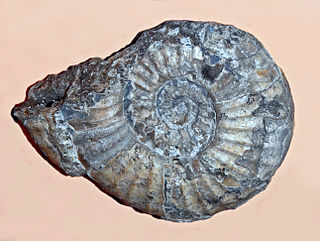
Arietitidae is a family of true ammonites that make up part of the superfamily Psiloceratoidea, named after the type genus Arietites. They comprise medium-size to large or gigantic genera which in general are strongly ribbed, tuberculate in some, with keeled or grooved and keeled venters, and well differentiated ammonitic sutures. The aptycus is single valved with a shiny, concentrically striated surface.
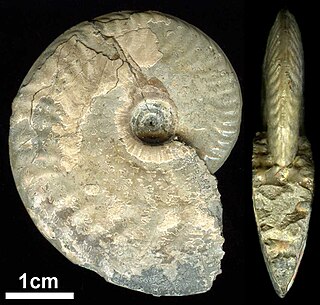
Oppeliidae are compressed to oxyconic, sculptured Haploceratoidea, either unkeeled, unicarinate, bicarinate, or tricarinate; with sutures in great variety, but ribbing usually more or less falcoid or falcate. The Oppeliidae is the principal family of the Haploceratoidea, with the longest duration, extending from the Middle Jurassic (Bajocian) to the Upper Cretaceous (Cenomanian) Their derivation is from the Hildoceratoidea.
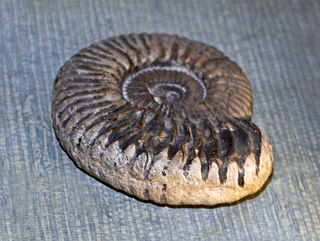
The Peltoceratinae comprise a subfamily in the Aspidoceratidae,.
The Aspidoceratinae is a subfamily in the perisphictacean ammonite family, Aspidoceratidae found world wide in middle and upper Jurassic sediments.
The Simoceratinae is a subfamily in the Aspidoceratidae, a family of ammonites in the Perisphinctaceae, that lived during most of the Late Jurassic, especially in the Pacific and Tethyan realms. Early genera more closely resemble Perisphictidae and have constricted apertures. Later, more aberrant forms are unconstricted and develop grooved or concave venters.

Desmoceratoidea, formerly Desmocerataceae, is a superfamily of Cretaceous ammonites, generally with round or oval-whorled shells that are mostly smooth or weakly ribbed and rarely tuberculate, but commonly with constrictions. Regarded as monophyletic, the Desmocerataceae are derived from the Phylloceratidae, splitting off in the Early Cretaceous (Valanginian) and persisting to the end of the Maastrichtian.

Hildoceratidae is a family of ammonoid cephalopods from the Lower Jurassic, lower Pliensbachian to lower Bajocian substages, generally with strongly ribbed, involute shells. They are combined with the Hammatoceratidae, Graphoceratidae, and Sonniniidae to make up the Hildoceratoidea.

Perisphinctidae is a family of Middle and Upper Jurassic discoidal ammonites in the order Ammonitida. They have a shell morphology that is mostly evolute, typically with biplicate, simple, or triplicate ribbing. Large forms have simple apertures and smooth body chambers while small forms have lappets and ribbed body chambers.
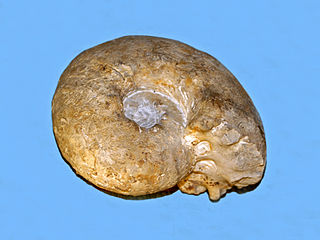
Orthaspidoceras is an extinct ammonoid cephalopod genus belonging to the family Aspidoceratidae. These nektonic carnivores lived during the Jurassic period, Kimmeridgian age.















